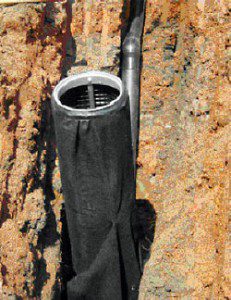In our last Tech Section, “Why NO Drainage System Can Wick Water,” we promised that in a future newsletter we would talk about when the Turf Drain Siphon System had application.
 There is much misunderstanding as to when and why someone should use a siphon as opposed to a gravity relief. The first thing that we should clarify is that the Turf Drain Siphon System is a transportation system, and not a collection system. However, having said that, a siphon basin does have the ability to collect surface water through its open inlet, and seepage water through its permeable sidewalls. But these collection components aren’t the determining factor as to when it should be used. The primary factor that determines when it is used is the available elevation change between the collection point and the relief.
There is much misunderstanding as to when and why someone should use a siphon as opposed to a gravity relief. The first thing that we should clarify is that the Turf Drain Siphon System is a transportation system, and not a collection system. However, having said that, a siphon basin does have the ability to collect surface water through its open inlet, and seepage water through its permeable sidewalls. But these collection components aren’t the determining factor as to when it should be used. The primary factor that determines when it is used is the available elevation change between the collection point and the relief.
One of the most important principles of proper drainage installations is “Self Cleaning Velocity.” This principle says that if a pipe isn’t installed on a steep enough gradient, contaminants will settle out, and over time, will restrict the flow of the pipe. We won’t go into the exact calculations here, but this is the source of the common guideline used in the golf course industry; that 4” pipe (plastic smooth wall) should be installed on a 1% slope (larger pipes can be installed with less of a gradient).
The primary factor that determines when it is used is the available elevation change between the collection point and the relief…”
The problem is that although most people are aware of this rule, and tries to adhere to it when the slope is easily available; there is no real alternative in areas where the slope can’t be achieved. Therefore in most cases, the course goes ahead with the installation at less than the required slope.
The Turf Drain Siphon System is designed for these applications. A siphon system is designed to drain down to an equilibrium point. At this point, the system stops draining, even though the pipe remains full of water. Therefore, at this point we have NO velocity. Since we have no velocity, we know that the contaminants that are in the water stream will settle out over time. Because of this, we design the system so that it can be flushed.
Since we have no velocity, we know that the contaminants that are in the water stream will settle out over time. Because of this, we design the system so that it can be flushed…”
A siphon system is built with HDPE pipe that is fused, and can be pressurized. This is the same pipe that is becoming popular in irrigation systems. We have been using this pipe for 20 years in our siphons because of its higher quality. The ability to pressurize the lines, and the connection we make to the irrigation system, means that self cleaning velocity will never stop you from being able to build a system with a long life.
This capability makes it possible to install the system in flood plains where contamination from a flood event can completely destroy a conventional system, even one that has “self cleaning velocity.”
